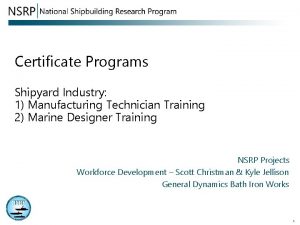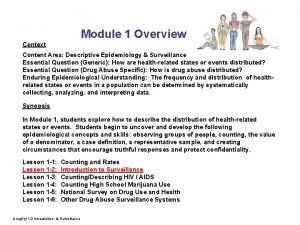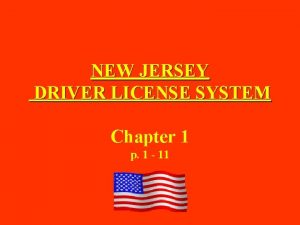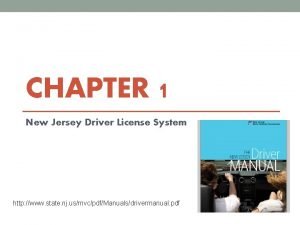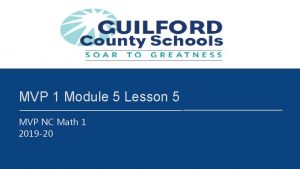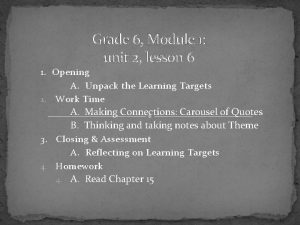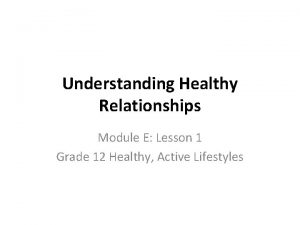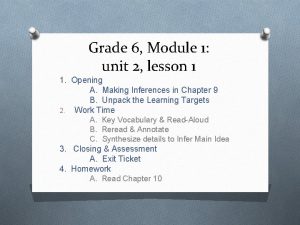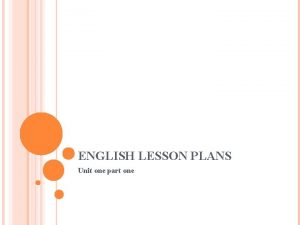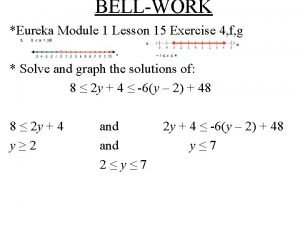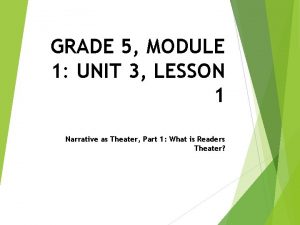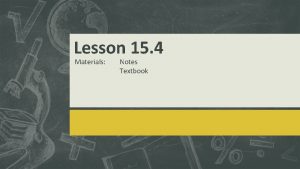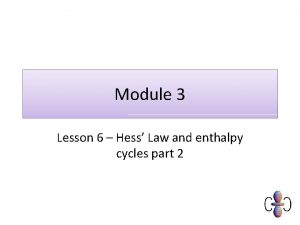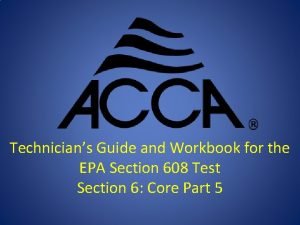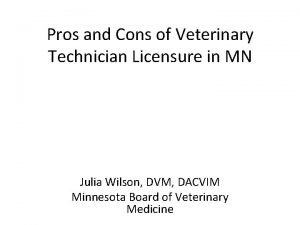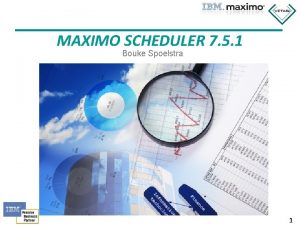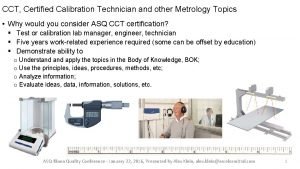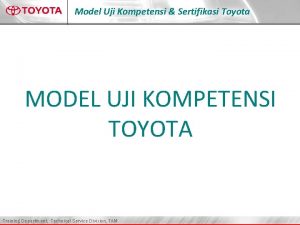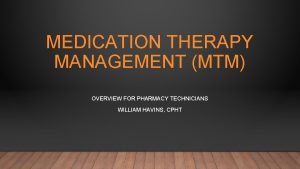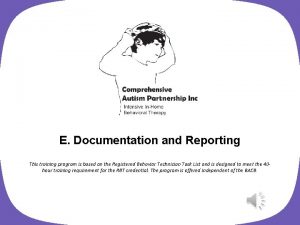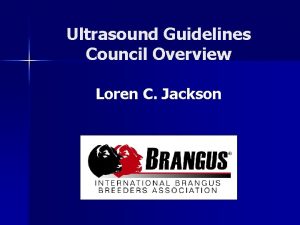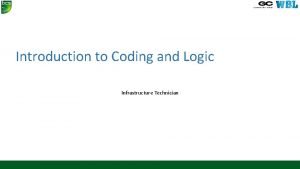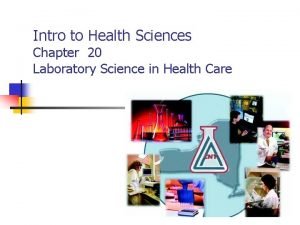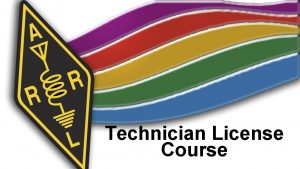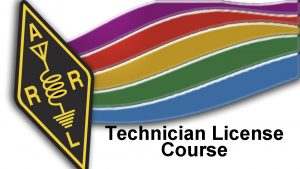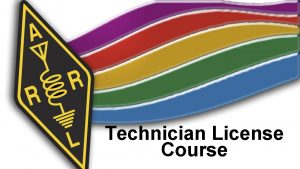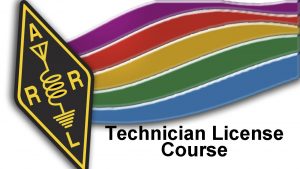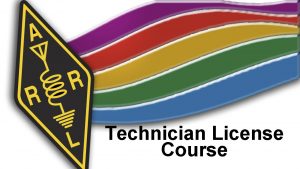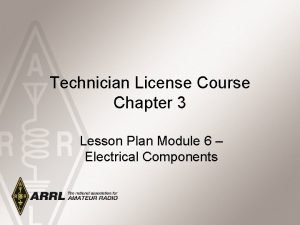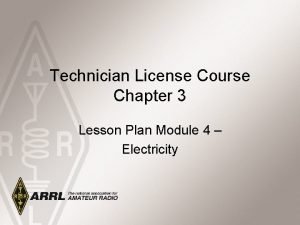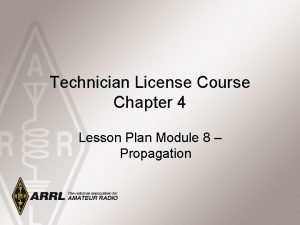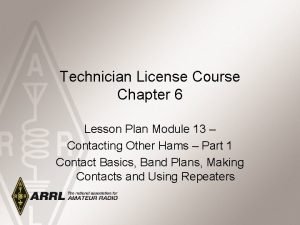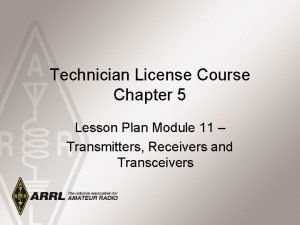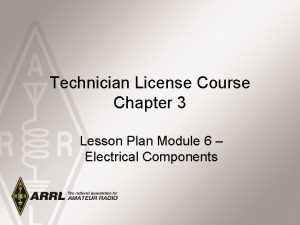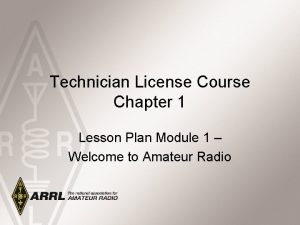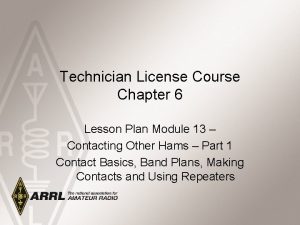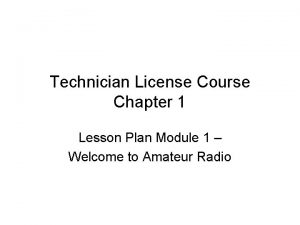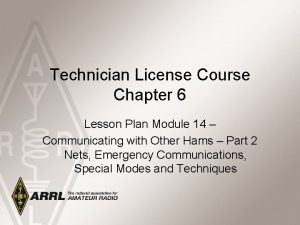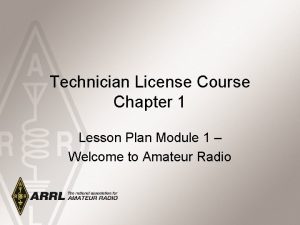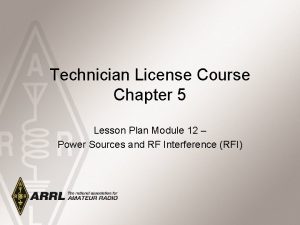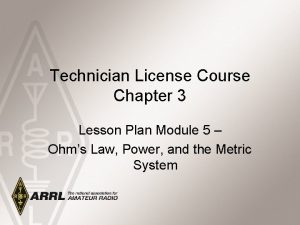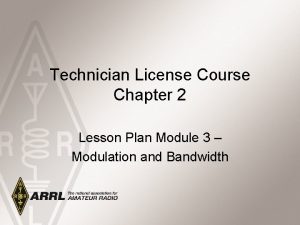Technician License Course Chapter 2 Lesson Plan Module













































- Slides: 45

Technician License Course Chapter 2 Lesson Plan Module 3 – Modulation and Bandwidth

The Basic Radio Station 2014 Technician License Course

What Happens During Radio Communication? • Transmitting (sending a signal): – Information (voice, data, video, commands, etc. ) is converted to electronic form. – The information in electronic form is added to a radio wave. – The radio wave carrying the information is sent from the station antenna into space. 2014 Technician License Course

What Happens During Radio Communication? • Receiving: – The radio wave carrying the information is intercepted by the receiving station’s antenna. – The receiver extracts the information from the received wave. – The information is then presented to the user in a format that can be understood (sound, picture, words on a computer screen, response to a command, etc. ). 2014 Technician License Course

What Happens During Radio Communication? • Adding and extracting the information can be simple or complex. • This makes ham radio fun…learning all about how radios work. • Don’t be intimidated. You will be required to only know the basics, but you can learn as much about the “art and science” of radio as you want. 2014 Technician License Course

Adding Information – Modulation • When we add some information to the radio wave, (the carrier) we modulate the wave. • Turn the wave on and off (Morse code) • Speech or music • Data • Different modulation techniques vary different properties of the wave to add the information: • Amplitude, frequency, or phase 2014 Technician License Course

Phase • Along with frequency and period, another important property of waves is phase. • Phase is a position within a cycle. • Phase is also a relative position between two waves. 2014 Technician License Course

CW - Morse Code – On and Off 2014 Technician License Course

Amplitude Modulation (AM) • In AM, the amplitude of the carrier wave is modified in step with the waveform of the information (the tone shown here). 2014 Technician License Course

Composite Signals • The process of adding information to an unmodulated radio wave creates additional signals called sidebands. • The sidebands and carrier work together to carry the information. • The combination of carrier and sidebands creates a composite signal. 2014 Technician License Course

Bandwidth • The carrier and sidebands have different frequencies, occupying a range of spectrum space. • The occupied range is the composite signal’s bandwidth. • Different types of modulation and information result in different signal bandwidths. 2014 Technician License Course

Characteristics of Voice AM Carrier Amplitude AM signals consist of three components: – Carrier – Lower sideband (LSB) – Upper sideband (USB) • AM bandwidth is twice the information bandwidth. LSB 799. 4 USB 800. 6 Frequency (k. Hz) AM signal being modulated by a 600 Hz tone 2014 Technician License Course

Characteristics of Voice Information • Sounds that make up voice are a complex mixture of multiple frequencies from 300– 3000 Hz • Two mirror-image sets of sidebands are created, each up to 3000 Hz wide. • AM voice signal bandwidth 2 x 3000 Hz = 6000 Hz 2014 Technician License Course

Single Sideband Modulation (SSB) • The two sets of voice sidebands carry duplicate information. • We can improve efficiency by transmitting only one sideband reconstructing the missing carrier in the receiver. • SSB bandwidth is only 3000 Hz for voice signals. 2014 Technician License Course

Frequency and Phase Modulation (FM and PM) • Instead of varying amplitude, if we use the information to vary the carrier’s frequency, frequency modulation (FM) is produced. • FM bandwidth (for voice) is between 5 and 15 k. Hz. • We can also shift the signal’s phase back and forth, creating phase modulation (PM) that is very similar to FM. 2014 Technician License Course

Typical Signal Bandwidths Type of Signal AM voice AM broadcast Commercial video broadcast SSB voice SSB digital CW FM voice FM broadcast Typical Bandwidth 6 k. Hz 10 k. Hz 6 MHz 2 to 3 k. Hz 500 to 3000 Hz (0. 5 to 3 k. Hz) 150 Hz (0. 15 k. Hz) 10 to 15 k. Hz 150 k. Hz 2014 Technician License Course

Practice Questions 2014 Technician License Course

Why should you not set your transmit frequency to be exactly at the edge of an amateur band or sub-band? A. To allow for calibration error in the transmitter frequency display B. So that modulation sidebands do not extend beyond the band edge C. To allow for transmitter frequency drift D. All of these choices are correct FCC Rule: [97. 101(a), 97. 301(a-e)] T 1 B 09 HRLM (2 -10) 2014 Technician License Course

Why should you not set your transmit frequency to be exactly at the edge of an amateur band or sub-band? A. To allow for calibration error in the transmitter frequency display B. So that modulation sidebands do not extend beyond the band edge C. To allow for transmitter frequency drift D. All of these choices are correct FCC Rule: [97. 101(a), 97. 301(a-e)] T 1 B 09 HRLM (2 -10) 2014 Technician License Course

What determines the amount of deviation of an FM (as opposed to PM) signal? A. Both the frequency and amplitude of the modulating signal B. The frequency of the modulating signal C. The amplitude of the modulating signal D. The relative phase of the modulating signal T 2 B 05 HRLM (2 -10) 2014 Technician License Course

What determines the amount of deviation of an FM (as opposed to PM) signal? A. Both the frequency and amplitude of the modulating signal B. The frequency of the modulating signal C. The amplitude of the modulating signal D. The relative phase of the modulating signal T 2 B 05 HRLM (2 -10) 2014 Technician License Course

What happens when the deviation of an FM transmitter is increased? A. Its signal occupies more bandwidth B. Its output power increases C. Its output power and bandwidth increases D. Asymmetric modulation occurs T 2 B 06 HRLM (2 -9) 2014 Technician License Course

What happens when the deviation of an FM transmitter is increased? A. Its signal occupies more bandwidth B. Its output power increases C. Its output power and bandwidth increases D. Asymmetric modulation occurs T 2 B 06 HRLM (2 -9) 2014 Technician License Course

Which of the following is a form of amplitude modulation? A. Spread spectrum B. Packet radio C. Single sideband D. Phase shift keying T 8 A 01 HRLM (2 -9) 2014 Technician License Course

Which of the following is a form of amplitude modulation? A. Spread spectrum B. Packet radio C. Single sideband D. Phase shift keying T 8 A 01 HRLM (2 -9) 2014 Technician License Course

What type of modulation is most commonly used for VHF packet radio transmissions? A. FM B. SSB C. AM D. Spread spectrum T 8 A 02 HRLM (2 -10) 2014 Technician License Course

What type of modulation is most commonly used for VHF packet radio transmissions? A. FM B. SSB C. AM D. Spread spectrum T 8 A 02 HRLM (2 -10) 2014 Technician License Course

Which type of voice modulation is most often used for long-distance or weak signal contacts on the VHF and UHF bands? A. FM B. DRM C. SSB D. PM T 8 A 03 HRLM (2 -11) 2014 Technician License Course

Which type of voice modulation is most often used for long-distance or weak signal contacts on the VHF and UHF bands? A. FM B. DRM C. SSB D. PM T 8 A 03 HRLM (2 -11) 2014 Technician License Course

Which type of modulation is most commonly used for VHF and UHF voice repeaters? A. AM B. SSB C. PSK D. FM T 8 A 04 HRLM (2 -10) 2014 Technician License Course

Which type of modulation is most commonly used for VHF and UHF voice repeaters? A. AM B. SSB C. PSK D. FM T 8 A 04 HRLM (2 -10) 2014 Technician License Course

Which of the following types of emission has the narrowest bandwidth? A. FM voice B. SSB voice C. CW D. Slow-scan TV T 8 A 05 HRLM (2 -10) 2014 Technician License Course

Which of the following types of emission has the narrowest bandwidth? A. FM voice B. SSB voice C. CW D. Slow-scan TV T 8 A 05 HRLM (2 -10) 2014 Technician License Course

Which sideband is normally used for 10 meter HF, VHF and UHF single-sideband communications? A. Upper sideband B. Lower sideband C. Suppressed sideband D. Inverted sideband T 8 A 06 HRLM (2 -11) 2014 Technician License Course

Which sideband is normally used for 10 meter HF, VHF and UHF single-sideband communications? A. Upper sideband B. Lower sideband C. Suppressed sideband D. Inverted sideband T 8 A 06 HRLM (2 -11) 2014 Technician License Course

What is the primary advantage of single sideband over FM for voice transmissions? A. SSB signals are easier to tune B. SSB signals are less susceptible to interference C. SSB signals have narrower bandwidth D. All of these choices are correct T 8 A 07 HRLM (2 -11) 2014 Technician License Course

What is the primary advantage of single sideband over FM for voice transmissions? A. SSB signals are easier to tune B. SSB signals are less susceptible to interference C. SSB signals have narrower bandwidth D. All of these choices are correct T 8 A 07 HRLM (2 -11) 2014 Technician License Course

What is the approximate bandwidth of a single sideband voice signal? A. 1 k. Hz B. 3 k. Hz C. 6 k. Hz D. 15 k. Hz T 8 A 08 HRLM (2 -5) 2014 Technician License Course

What is the approximate bandwidth of a single sideband voice signal? A. 1 k. Hz B. 3 k. Hz C. 6 k. Hz D. 15 k. Hz T 8 A 08 HRLM (2 -5) 2014 Technician License Course

What is the approximate bandwidth of a VHF repeater FM phone signal? A. Less than 500 Hz B. About 150 k. Hz C. Between 10 and 15 k. Hz D. Between 50 and 125 k. Hz T 8 A 09 HRLM (2 -5) 2014 Technician License Course

What is the approximate bandwidth of a VHF repeater FM phone signal? A. Less than 500 Hz B. About 150 k. Hz C. Between 10 and 15 k. Hz D. Between 50 and 125 k. Hz T 8 A 09 HRLM (2 -5) 2014 Technician License Course

What is the typical bandwidth of analog fastscan TV transmissions on the 70 cm band? A. More than 10 MHz B. About 6 MHz C. About 3 MHz D. About 1 MHz T 8 A 10 HRLM (2 -5) 2014 Technician License Course

What is the typical bandwidth of analog fastscan TV transmissions on the 70 cm band? A. More than 10 MHz B. About 6 MHz C. About 3 MHz D. About 1 MHz T 8 A 10 HRLM (2 -5) 2014 Technician License Course

What is the approximate maximum bandwidth required to transmit a CW signal? A. 2. 4 k. Hz B. 150 Hz C. 1000 Hz D. 15 k. Hz T 8 A 11 HRLM (2 -5) 2014 Technician License Course

What is the approximate maximum bandwidth required to transmit a CW signal? A. 2. 4 k. Hz B. 150 Hz C. 1000 Hz D. 15 k. Hz T 8 A 11 HRLM (2 -5) 2014 Technician License Course
 Manufacturing technician license
Manufacturing technician license Manufacturing tech license
Manufacturing tech license Micro lesson plans
Micro lesson plans C device module module 1
C device module module 1 Front line leadership definition
Front line leadership definition Course module sample
Course module sample Where did the ravi hide the kitten
Where did the ravi hide the kitten One and half brick wall
One and half brick wall Course number and title
Course number and title Chaine parallèle muscle
Chaine parallèle muscle Getting a driver license illegally may result in:
Getting a driver license illegally may result in: Chapter 1 the new jersey driver license system answers
Chapter 1 the new jersey driver license system answers Chapter 1 the new jersey driver license system answers
Chapter 1 the new jersey driver license system answers An overall state of well-being or total health
An overall state of well-being or total health Lesson 3 a new plan of government answer key
Lesson 3 a new plan of government answer key Hardship and suffering lesson 2
Hardship and suffering lesson 2 Module 5 lesson 5
Module 5 lesson 5 Grade 8 module 1 unit 1 lesson 6 answer key
Grade 8 module 1 unit 1 lesson 6 answer key Practical/logistical issues in relationships
Practical/logistical issues in relationships Grade 6 module
Grade 6 module Module eleven lesson one self check quiz
Module eleven lesson one self check quiz Eureka math algebra 1 module 1 lesson 15
Eureka math algebra 1 module 1 lesson 15 Grade 5 module 1 lesson 1
Grade 5 module 1 lesson 1 Intersecting chords
Intersecting chords Enthalpy of formation hess law
Enthalpy of formation hess law When preparing an iv solution a technician should work
When preparing an iv solution a technician should work How long must a technician evacuating refrigerant
How long must a technician evacuating refrigerant Vet tech pros and cons
Vet tech pros and cons Ibm maximo scheduler
Ibm maximo scheduler Asq cct
Asq cct Define career cluster
Define career cluster Radar and sonar technician career cluster
Radar and sonar technician career cluster Technician a says that the bulb trade number
Technician a says that the bulb trade number Toyota technician certification
Toyota technician certification Micromain mobile
Micromain mobile Mtm pharmacy technician
Mtm pharmacy technician Maximo scheduling software
Maximo scheduling software Sample aba session notes
Sample aba session notes Surface repair technician
Surface repair technician Safety health and environment apprenticeship
Safety health and environment apprenticeship Translator
Translator Live technician
Live technician Carcass ultrasound technician training
Carcass ultrasound technician training Bcs level 3 infrastructure technician
Bcs level 3 infrastructure technician A csi lab technician _____.
A csi lab technician _____. Horticultural technician apprentice
Horticultural technician apprentice
